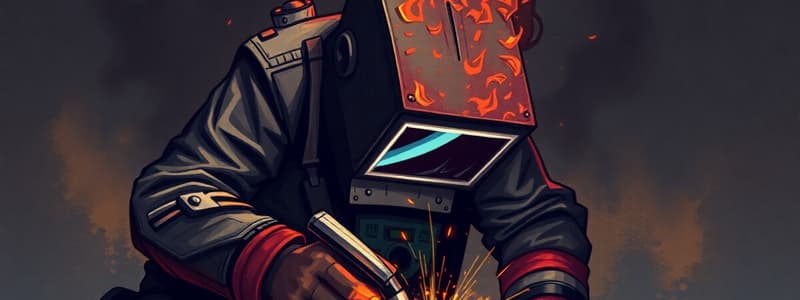Podcast
Questions and Answers
Which statement accurately describes the role of shielding gas in Gas Metal Arc Welding (GMAW)?
Which statement accurately describes the role of shielding gas in Gas Metal Arc Welding (GMAW)?
- It protects the weld pool from atmospheric contaminants like oxygen and nitrogen. (correct)
- It provides additional filler metal to the weld pool.
- It cools the weld area to prevent overheating and distortion.
- It increases the electrical conductivity between the electrode and the workpiece.
In GMAW, what is the primary function of the wire feeder?
In GMAW, what is the primary function of the wire feeder?
- To supply electrical current to the welding wire.
- To deliver the welding wire to the welding gun at a controlled rate. (correct)
- To regulate the flow of shielding gas to the welding gun.
- To cool the welding gun and prevent overheating.
Which GMAW metal transfer mode is best suited for welding thin materials and requires low heat input?
Which GMAW metal transfer mode is best suited for welding thin materials and requires low heat input?
- Spray transfer
- Short-circuit transfer (correct)
- Pulsed spray transfer
- Globular transfer
What effect does increasing the wire extension (stick-out) in GMAW have on the welding process?
What effect does increasing the wire extension (stick-out) in GMAW have on the welding process?
Which of the following shielding gases is most likely to cause increased spatter when welding carbon steel?
Which of the following shielding gases is most likely to cause increased spatter when welding carbon steel?
In GMAW, what is the likely result of using an insufficient gas flow rate?
In GMAW, what is the likely result of using an insufficient gas flow rate?
Which GMAW welding technique typically provides deeper penetration and a narrower weld bead?
Which GMAW welding technique typically provides deeper penetration and a narrower weld bead?
What is a common cause of 'lack of fusion' in GMAW?
What is a common cause of 'lack of fusion' in GMAW?
Why is GMAW generally not recommended for use in very windy outdoor conditions?
Why is GMAW generally not recommended for use in very windy outdoor conditions?
What is the purpose of using argon/oxygen mixtures as a shielding gas for stainless steel in GMAW?
What is the purpose of using argon/oxygen mixtures as a shielding gas for stainless steel in GMAW?
Which of the following is a key advantage of GMAW over other welding processes?
Which of the following is a key advantage of GMAW over other welding processes?
What is the function of a ground clamp in GMAW?
What is the function of a ground clamp in GMAW?
Define 'burn-through' in the context of GMAW and identify its primary cause.
Define 'burn-through' in the context of GMAW and identify its primary cause.
When welding aluminum with GMAW, what specific preparation is crucial to ensure a high-quality weld?
When welding aluminum with GMAW, what specific preparation is crucial to ensure a high-quality weld?
Which joint type is specifically designed for joining two pieces of metal that overlap each other?
Which joint type is specifically designed for joining two pieces of metal that overlap each other?
Flashcards
MIG Welding (GMAW)
MIG Welding (GMAW)
Arc welding process using a continuous wire electrode and shielding gas.
Arc Formation
Arc Formation
An electrical arc melts the base metal and the electrode, forming a weld pool.
Shielding Gas
Shielding Gas
Protects the weld pool from atmospheric contamination.
Short-Circuit Transfer
Short-Circuit Transfer
Signup and view all the flashcards
Spray Transfer
Spray Transfer
Signup and view all the flashcards
Wire Feeder
Wire Feeder
Signup and view all the flashcards
Argon Shielding Gas
Argon Shielding Gas
Signup and view all the flashcards
Voltage (Welding)
Voltage (Welding)
Signup and view all the flashcards
Amperage/Wire Feed Speed
Amperage/Wire Feed Speed
Signup and view all the flashcards
Wire Extension (Stick-out)
Wire Extension (Stick-out)
Signup and view all the flashcards
Butt Joint
Butt Joint
Signup and view all the flashcards
Push Technique
Push Technique
Signup and view all the flashcards
Porosity
Porosity
Signup and view all the flashcards
Lack of Fusion
Lack of Fusion
Signup and view all the flashcards
Undercut (Welding)
Undercut (Welding)
Signup and view all the flashcards
Study Notes
- MIG (Metal Inert Gas) welding, also known as Gas Metal Arc Welding (GMAW), is an arc welding process where a continuous solid wire electrode is fed through a welding gun and into the weld pool, joining two base materials together
- A shielding gas is also fed through the welding gun, which protects the weld pool from contamination
Key Principles
- An electrical arc forms between the consumable wire electrode and the workpiece The heat of the arc melts the base metal and the electrode, forming a weld pool
- The wire electrode continuously feeds, replenishing the weld pool
- Shielding gas protects the weld pool from atmospheric contamination such as oxygen, nitrogen, and hydrogen which can cause porosity and reduced weld strength
- The process can be semi-automatic or fully automated
Process Variations
- GMAW is categorized based on the type of metal transfer from the electrode to the weld pool
- Short-circuit transfer: Low heat input process suitable for thin materials, the electrode touches the weld pool and creates a short circuit
- Globular transfer: Uses larger diameter electrodes and higher welding currents, resulting in larger droplets transferring across the arc
- Spray transfer: High heat input process producing a fine spray of molten metal across the arc gap, suitable for thicker materials, uses higher voltage and amperage than short circuit
- Pulsed spray transfer: Uses pulses of welding current to achieve spray transfer at lower average currents
Equipment
- Welding Power Source: Provides a constant voltage (CV) or constant current (CC) DC power supply
- Wire Feeder: Delivers the welding wire to the welding gun at a controlled and consistent rate
- Welding Gun: Directs the welding wire and shielding gas to the weld area, also provides electrical current to the wire
- Shielding Gas Supply: Includes a gas cylinder, regulator, and flow meter to control the flow of shielding gas
- Ground Clamp: Completes the electrical circuit by attaching to the workpiece
Shielding Gases
- Argon: Used for welding aluminum, stainless steel, and other non-ferrous metals
- Helium: Provides deeper penetration and a hotter arc than argon
- Carbon Dioxide: Used for welding carbon steel, and is a reactive gas, so it can cause more spatter
- Argon/CO2 mixtures: Commonly used for carbon steel, balancing arc stability, penetration, and spatter
- Argon/Oxygen mixtures: Used for stainless steel to improve arc stability and reduce oxidation
Welding Parameters
- Voltage: It affects the arc length and width of the weld bead
- Amperage (Wire Feed Speed): It controls the amount of welding current and deposition rate
- Travel Speed: It affects the weld bead size, penetration, and heat input
- Wire Extension (Stick-out): Distance from the contact tip to the workpiece, affects current density and penetration
- Gas Flow Rate: Insufficient flow can lead to porosity, excessive flow can cause turbulence and loss of shielding
Advantages
- High welding speeds compared to other welding processes
- High deposition rates increasing productivity
- Suitable for welding a wide range of metals and thicknesses
- Relatively clean welds with minimal slag
- Can be automated for high-volume production
Disadvantages
- Equipment is more complex and costly than other welding processes
- Can be difficult to use in windy conditions due to shielding gas displacement
- Potential for burn-through on thin materials if parameters are not properly set
- Not suitable for all welding positions, such as overhead, with some transfer modes
Materials Welded
- Carbon Steels: Most common material welded with GMAW, typically using CO2 or Ar/CO2 shielding gas
- Stainless Steels: Welded with argon-based shielding gas mixtures, often with oxygen or helium additions
- Aluminum: Typically welded with argon shielding gas, requires careful cleaning to remove oxides
- Magnesium: Welded with argon or argon/helium mixtures
- Copper Alloys: Welded with argon-based shielding gases
Joint Design
- Butt Joints: Used to join two pieces of metal end-to-end, can be open or closed depending on material thickness
- Lap Joints: Used to join two pieces of metal overlapping each other
- Tee Joints: Used to join two pieces of metal at a 90-degree angle
- Corner Joints: Used to join two pieces of metal forming a corner
- Edge Joints: Used to join two pieces of metal along their edges
Welding Techniques
- Push Technique: Welding gun is pushed away from the weld pool, provides shallower penetration and a wider bead
- Pull Technique: Welding gun is pulled towards the weld pool, provides deeper penetration and a narrower bead
- Weaving: Sideways motion of the welding gun to widen the weld bead and distribute heat
- Stringer Beads: Straight weld beads without weaving, used for single-pass welds or root passes
Common Problems
- Porosity: Caused by contamination of the weld pool, insufficient shielding gas, or improper welding parameters
- Lack of Fusion: Occurs when the base metal is not properly melted and fused with the weld metal
- Burn-Through: Excessive heat input melts through the base metal, creating a hole
- Undercut: A groove melted into the base metal along the toe of the weld
- Spatter: Molten metal particles that are expelled from the weld area
Safety Precautions
- Wear appropriate personal protective equipment (PPE), including welding helmet, gloves, and protective clothing
- Ensure adequate ventilation to remove fumes and gases
- Protect nearby personnel from arc flash and spatter
- Use proper grounding techniques to prevent electrical shock
- Handle compressed gas cylinders with care
- Be aware of fire hazards and have a fire extinguisher nearby
Studying That Suits You
Use AI to generate personalized quizzes and flashcards to suit your learning preferences.




